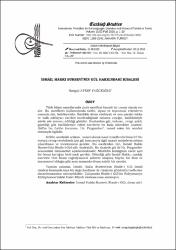| dc.contributor.author | Aydın Yağcıoğlu, Songül | en_US |
| dc.date.accessioned | 2019-10-29T17:59:57Z | |
| dc.date.available | 2019-10-29T17:59:57Z | |
| dc.date.issued | 2016 | |
| dc.identifier.issn | 1308-2140 | |
| dc.identifier.uri | http://www.trdizin.gov.tr/publication/paper/detail/TWpjeU9EQXlNZz09 | |
| dc.identifier.uri | https://hdl.handle.net/20.500.12294/2273 | |
| dc.identifier.uri | http://dx.doi.org/10.7827/TurkishStudies.9892 | |
| dc.description.abstract | Türk İslam sanatlarında çiçek motifleri önemli bir unsur olarak yer alır. Bu motiflerin kullanımında tarihi, siyasi ve toplumsal etkenlerin yanında din, belirleyicidir. Özellikle divan edebiyatı ve ona paralel tekke ve halk edebiyatı eserleri incelendiğinde onlarca çiçeğin, özellikleriyle şiirde söz konusu edildiği görülür. Bunlardan gül; kokusu, rengi, şekli, güzelliği gibi özellikleriyle edebî eserlerde en fazla zikredilen çiçektir. Gülün bu üstün konumu, Hz. Peygamber'i temsil eden bir sembol olmasıyla ilgilidir. Gülün sembolik anlamı, nazari olarak nasıl temellendirilmiştir? Bu soruya cevap verebilmek için gül konusuyla ilgili nazari metinlerin ortaya çıkarılması ve incelenmesi gerekir. Bu eserlerden biri, İsmâil Hakkı Bursevî'nin Risâle-i Gül adlı risalesidir. Bu risalede gül ile Hz. Peygamber arasındaki münasebet açıklanmaktadır. Müellifin kimliğinin esere ayrı bir önem kattığını belirtmek gerekir. Bilindiği gibi İsmâil Hakkı, yazdığı eserlerle tüm İslam coğrafyasında şöhrete ulaşmış büyük bir âlim ve mutasavvıf olduğu gibi aynı zamanda divan sahibi bir şairdir. Yapılan çalışma, İsmâil Hakkı Bursevî'nin Risâle-i Gül isimli risalesi hakkında kısa bir değerlendirme ile risalenin günümüz harflerine aktarılmasından müteşekkildir. Çalışmada Risâle-i Gül'ün Süleymaniye Kütüphanesi'ndeki Halet Efendi nüshası esas alınmıştır | en_US |
| dc.description.abstract | Floral motifs take place as an important element of Turkish Islamic arts. Religion is a defining factor in application of these motifs, as well as historical, political and social factors. In particular, when works of divan literature and its parallel lodge and folk literature are examined, it is seen that dozens of flowers, with their properties are mentioned in poetry. Among these, rose; with its smell, color, shape, and beauty, is the most cited in literature. This outstanding status of rose, is associated with the fact that it is a symbol that represents the Prophet. How is the symbolic meaning of rose noetically based? In order to answer this question, noetic texts about rose must be uncovered and examined. One of these works, is the tract of İsmâil Hakkı Bursevî named Risâle-i Gül. In this tract, the relationship between rose and the Prophet is explained. It should be noted that the author’s identity gives the work a special importance. As is known, İsmâil Hakkı, is a great scholar that reached fame in the entire Islamic world with his work, a sufi mystic, and is also a classical divan poet. This study consists of a short evaluation of İsmâil Hakkı Bursevî’s Risâle-i Gül tract, and the conversion of the tract to letters of today. The study is based on the copy of the work in Süleymaniye | en_US |
| dc.language.iso | tur | en_US |
| dc.relation.ispartof | Turkish Studies (Elektronik) | en_US |
| dc.identifier.doi | 10.7827/TurkishStudies.9892 | en_US |
| dc.identifier.doi | 10.7827/TurkishStudies.9892 | |
| dc.rights | info:eu-repo/semantics/openAccess | en_US |
| dc.subject | Sosyal Bilimler | en_US |
| dc.subject | Disiplinler Arası | en_US |
| dc.title | İsmâil Hakkı Bursevî’nin Gül Hakkındaki Risalesi | en_US |
| dc.title.alternative | Leaflet of İsmâil Hakkı Bursevî About Rose | en_US |
| dc.type | article | en_US |
| dc.department | İstanbul Arel Üniversitesi, Fen-Edebiyat Fakültesi Türk Dili ve Edebiyatı Bölümü | en_US |
| dc.identifier.volume | 11 | en_US |
| dc.identifier.issue | 20 | en_US |
| dc.identifier.startpage | 1 | en_US |
| dc.identifier.endpage | 10 | en_US |
| dc.relation.publicationcategory | Makale - Ulusal Hakemli Dergi - Kurum Öğretim Elemanı | en_US |
| dc.institutionauthor | Aydın Yağcıoğlu, Songül | en_US |


















